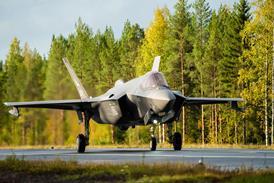Eight months after crashing on her second test flight and being spirited indoors for repairs, the Airlander prototype re-emerged from her Cardington airfield hangar on the evening of 7 April, with Hybrid Air Vehicles looking to resume flight testing within days. Staff have spent their time since the 24 August hard landing absorbing recommendations from the UK Air Accidents Investigation Branch report, and incorporating additional safety features to the world’s largest flying structure – including a new winch system and “air bags” to to protect the cabin during a high-pitched landing.
Although HAV says the hiatus has cost £7 million ($8.7 million), the Bedford-based company remains upbeat about prospects for the 92m-long hybrid airship, insisting the delay has provided the opportunity to fine-tune the design. HAV has also outlined details of its strategy to become profitable – in the short-term using the prototype as a platform for gathering data, and longer-term by entering production, with the company confident of signing up an overseas military launch customer in the next few months.
For any start-up depending on shareholder largesse – especially one foisting a revolutionary aircraft on the industry – crashing a prototype on its second sortie could have proved disastrous. However, chief executive Stephen McGlennan insists HAV’s 2,000 private shareholders – who range from multi-milionnaire enthusiasts such as Iron Maiden’s Bruce Dickinson to those who have purchased stakes worth a few thousand pounds through crowdfunding – have remained supportive, even after HAV watered down their equity by seeking additional funds.

Geoff Robinson Photography/REX/Shutterstock
“We have taken the attitude that whatever doesn’t kill you makes you stronger,” says McGlennan. “One positive is that our procedures are a quantum leap ahead of where they were. So in the long term we will look back and say [the mishap] was helpful.” Of the additional £7 million raised, £2.6 million was spent on repairing the damaged flightdeck and cabin. The rest has gone on design improvements, he says. However, he admits the past eight months have been difficult. “It was not a nice thing to go through,” he concedes.
There are two main changes to the design prompted by the circumstances of the crash, which occurred when a mooring line fell free from its temporary stowage position, got entangled in wires next to the airfield and led to the pilot landing at a sharper angle than intended. Although neither crew member was hurt, the cockpit was substantially damaged, necessitating the eight-month repair and a period of introspection by the company that initially designed the Airlander in the late 2000s for a subsequently-cancelled US military contract.
Two 3m- (10ft)-long, pilot-deployable inflatable airbags – an “auxilliary landing system” to the existing twin air-filled skids – have been added, giving the aircraft an extra cushion to land on in the event of a sharp approach. The second enhancement is the replacement of the towable mooring mast with an integrated, mobile version. This makes it easier to control and push back the aircraft when maneuvering it around the airfield, says HAV. The machine also includes a retracting mechanism for the mooring line, winching it in once the aircraft is on the ground and avoiding the risk of the line dangling from the aircraft during approach.

Geoff Robinson Photography/REX/Shutterstock
McGlennan and his backers know that getting Airlander aloft again – and even to certification – is only the beginning of a long process to bring HAV to profitability. However, he believes that the company can break even with just one aircraft, generating income by selling data from the flight test programme to military and other customers. If ongoing negotiations are successful, a two-aircraft, roughly £90 million order from a “non-UK” military customer this summer could unlock further funding, says McGlennan, allowing HAV to “scale the business”.
Introducing a production line, he says, would cost some £70 million – HAV’s business model is to use a fully-outsourced supply chain, with only design and final assembly taking place in the historic hangar at Cardington. That would be raised through an initial public offering and taking on more debt. “We know that with orders, we can raise cash,” he says. Eventually, the “medium-term objective” is for HAV to be in a “steady state” by 2021, producing some 12 aircraft a year – the same number, incidentally, as the Airbus A380’s likely output at the turn of the decade.
“We are confident about our route to commercialisation,” says McGlennan. Potential markets for the five-day endurance aircraft include communications companies – who might use it as a “pop-up” mast over an area where broadband connections have been lost – and the defence sector. “We have never lost our ambition to get back into the US military,” he says. An eventual passenger version might even offer 7h “Orient Express-style” VIP cruises from the UK down the Rhine to Friedrichshafen, birthplace of the Zeppelin.

Geoff Robinson Photography/REX/Shutterstock
Source: Flight International


























